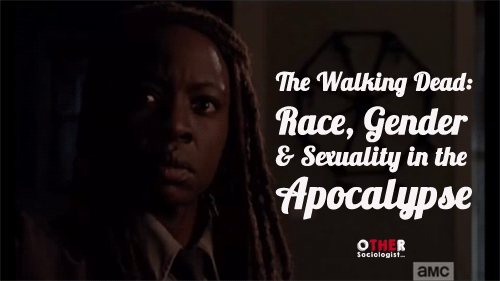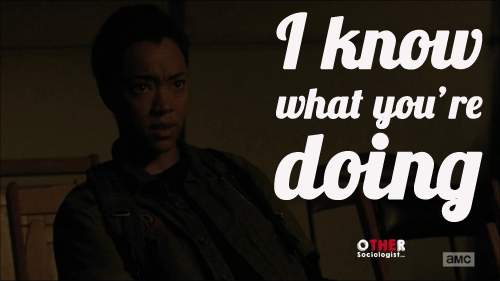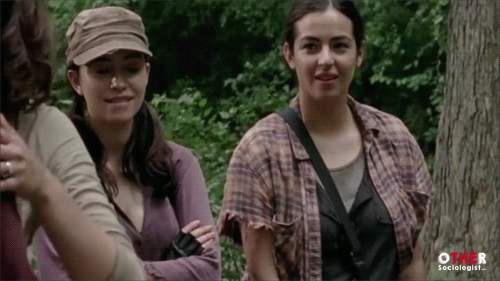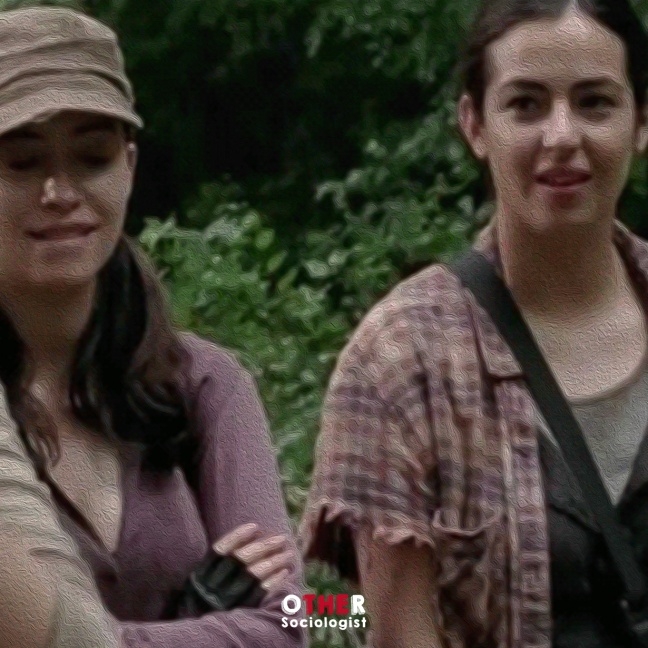This article was first published on Medium, 2 April 2015
Warning: analysis and spoilers for Seasons 1 to 5.
Like millions of fans around the world, I love The Walking Dead, and I’m an avid horror aficionado. Yet after five seasons, with breathtaking plot twists and turns, The Walking Dead’s treatment of gender, race and sexuality remains stagnant. For a show that takes many liberties when asking the audience to suspend disbelief, there’s one area it has no trouble maintaining a familiar narrative: the dominance of White, heterosexual men.
Since it launched, the show has focused on relationships and character development. This proved a novel way to bring horror to popular TV. Anthropologist, Professor Juan Francisco Salazar and Dr Stephen Healy, a geographer, argue that Season Five “reflects on the meaning of group solidarity in a brave new world.” The researchers demonstrate how various social science readings of the show centre on social anxiety. In their view, this most recent season was concerned with “Rick’s communitarian family.” That is, the other characters on the show who have bound together supposedly through Rick’s leadership, even when there have been long periods (notably Season 3) when Rick provided little guidance.
The show invites its audience to consider their own bravery under zombie duress. Would we panic and leave sweet Noah stuck in a revolving door swarming with zombies? Would we become “weak” within the walls of Alexandria? Should this frustrating person or that annoying character be killed? The show does not encourage us to think about why the writers persist on upholding White men as leaders, and why White women, people of colour and other minorities are notably absent from the narrative landscape.
It’s no accident that the diplomatic and inclusive leadership of Deanna (a White woman), flawed as it may be, is presented as fundamentally irrational because of its inclusive ideals. Meanwhile, Rick, a White man, is presented as the only model for viable leadership in spite of his flaws.

Rick
Though Rick has shown many admirable qualities over the years, he is by no means the only fit leader in the group. In fact, he has became increasingly frustrating in his decision-making. One of the most irritating plot points in recent times is Rick’s motivation to save Jessie, a White woman, from domestic violence because of his lust, rather than helping her because it is the right thing to do. He’s done so in a way that further endangers not only Jessie and her son, but also Rick’s group. Rick has been reckless in trying to claim this woman for his own, putting his desire above the needs of his community.
The residents of Alexandria, where Jessie has been waiting out the apocalypse, ignored the abuse because it was easier to coddle her abusive husband, the town’s only surgeon. Rick’s use of violence to possess Jessie is depicted as the most sensible option, when in fact, his motivations are objectifying and dangerous. He hardly knows her, but wants to rescue her for himself. This is familiar “Wild West” movie territory where women are objects to be conquered, not full characters with a story of their own.

Michonne
Michonne is a strong and intriguing character, and a potential leader, but she plays second fiddle to Rick. Of all the other major characters, it took the longest to learn of her back story. This is not without consequence, given she is a Black woman. White people generally have an easier time believing that Black people are both subhuman and superhuman, rather than complex people much like themselves. That is, White people tend to believe the stereotype that Black people are more prone to violence than White people and therefore that they are less deserving of protection (subhuman). At the same time, White people believe see Black people have higher physical strength, that they are capable of almost magical feats, while and also being less prone to feeling pain (superhuman). Neither stereotype is factual, but these biases are used to justify violence against Black people. For most of the show Michonne was cast in this light, as an outcast who revelled in killing. It took a long time for the writers to let us see another side to her, and this is not the only time they’ve relied on this characterisation of Black people (for example Sasha, below).
For a long time, Michonne was simply a warrior whose greatest asset was her capacity for swift, lethal action, and thus her humanity was not initially part of her appeal to audiences, as it was with the other major characters. Michonne came to the group emotionally damaged, having lost her family and subsequently spending too much time surviving in solitude, but she quickly proved herself loyal. More than her skills with her iconic katana, Michonne looks out for the wellbeing of others in a way that Rick does not. We see her reaching out to Rick’s son, Sasha and others who have lost loved ones. She does so without imposing her will or value judgement, as we’ve seen Rick do with others, including the community of Alexandria.
The significance of a Black woman performing unrecognised emotional labour in a world that otherwise ignores her emotional and psychological strength may be overlooked by The Walking Dead writers, but it fits perfectly with social expectations placed on Black women. Women of colour in general are expected to rise above stigma and discrimination and provide care work, while their resilience, leadership and other work are otherwise not rewarded.
In the past two seasons, Michonne has become a major voice of reason for the group. Michonne is important in helping Rick to sort through his frail sense of right and wrong. She listens to him and supports him even when she disagrees. Why the group looks to Rick, and not Michonne, for leadership defies logic.
Michonne is also one of the few people of colour on the show to have lasted more than a few episodes. This is a pattern of modern post-apocalyptic storytelling, where people of colour hardly exist, or do not make it far. Yes, there are a couple of notable examples; but for every 28 Days Later we have dozens of other films where people of colour are killed off early, usually after serving the role of “tough Black guy.”

Sasha
Sasha, another Black woman on The Walking Dead, is rendered as angry and irrational, and given little to do other than shoot zombies (or lie on top of them for a rest). Her psychology is not used to explore grief; but rather in the end, as a means to grant redemption to a man — a cowardly and vindictive priest (another rare person of colour on the show — Gabriel Stokes).
Rosita is one of only a couple of key Latin characters to have ever appeared on the show. A curious pattern, given that Latinos make up 17% of the USA’s population. It is not insignificant that she’s spent most of the show in revealing clothing, and semi-naked in a couple of sex scenes, in a show with few sex scenes. Latinas are more likely than any other racial group to be represented naked or semi-nude on screen.

Glenn
Glenn is the only other remaining person of colour on the show with a significant role. He is lethal to zombies, yet otherwise compassionate to humans. Like Michonne, Glenn symbolises an alternative model of leadership, yet his, and Michonne’s, desire to settle down in a less brutal model of community is ignored by Rick.
People of colour are disposable on The Walking Dead: they are inserted in and almost immediately rubbed out, as if to fulfil a tiny quota. Every time we lose one person of colour we gain another one. People of colour are interchangeable and permissible only in small doses. When a new character of colour is introduced, we have to fear for the longevity of another of the few existing people of colour.

Tara and the disposable women
Tara, a lesbian, was the first major character introduced to the cast who was not heterosexual. This was in Season 4. By the end of Season 5, we only have two additions: White, gay men. They are in a loving relationship, at least, but still marginal in the White heterosexual utopia of Alexandria. The fact that Lesbian, Gay, Bisexual, Transgender, Queer, Intersex and Asexual(LGBTQIA) people are next to invisible in The Walking Dead suggests that heterosexuality has somehow triumphed over alternative genders and sexualities at the end of the world. This is a curious, and conformative, plot decision that ensures heterosexuality remains the norm in the apocalypse.
Of the remaining central characters, the only other women are Maggie and Carol, both White and heterosexual. They are highly resourceful, even as other women side characters are presented as frail, in need of protection or otherwise voiceless background fodder. Women in general have been treated poorly throughout the show, often cast in the role of docile victims (Amy; Beth for the most part). Otherwise they are treated as Jezebels (Andrea), or chattels for men to fight over (Lori; and now new Lori — AKA Jessie). Whether they are cast as “saints or sluts” (because false dichotomies apparently matter in the apocalypse), the show has seldom respected the autonomy of women.

Carol
Carol’s story arc is easily one of the most interesting this season, because it breaks this pattern. After first introducing Carol as an (accidental) abuse survivor, and a meek motherly figure, she is now the only woman allowed to revel in a wicked sense of survival. This is probably no accident; having lost her child, and other surrogate children along the way, Carol is older, past her child-bearing responsibilities, and therefore positioned as undesirable. Beth started to become interesting as a character only as the show also primed her for sexual tension with Daryl. She was promptly killed off. Carol has been one of the few women allowed to grow and change without paying with her life. Carol’s transformation is a visceral delight in many ways, because so few women on the show are given the freedom to break conventional gender patterns.
It is no accident that in a show about the end of the world as we know it — strong, independent women, irrepressible people of colour and other minorities, are rare. The Walking Dead story was conceived of by Robert Kirkman, a White male heterosexual graphic novel artist and developed for TV by Frank Darabont, a White heterosexual man. In imagining the end of the world, White straight dudes think they’ll be the last ones standing, and that White women, people of colour and other minorities will simply go along with the prevailing social order that led to the apocalypse in the first place. For all its strong points, The Walking Dead fails to conceive of a new vision for civilisation that breaks the dominance of Whiteness and patriarchy.

Inequality in the Apocalypse
The thrilling cliff hanger introduction of Morgan Jones as a benevolent master fighter has potential to disrupt this narrative. It can go in a couple of ways: Morgan will be treated as a serious and nuanced character, who will challenge the dynamics of the group for the better. Or he will ultimately become yet another person of colour casualty of The Walking Dead. Whatever happens, here’s hoping he’s not pushed into the tired film and TV trope of the Black man whose ultimate purpose is to support the White saviour (Rick) fulfil his personal transformation.
For all its strengths, the social dynamics on The Walking Dead replicate many problems from modern society. These issues of power are not thoughtfully explored and it seems a missed opportunity for an otherwise expertly crafted show. Gender, race and sexual inequalities are reproduced as taken-for-granted facts, immune to the zombie apocalypse. In a brave new fictional world of endless possibilities, The Walking Dead elects to hand the reins to White heterosexual men, even when they are not fit to lead.
Fiction allows writers to break norms, to paint new worlds where even corpses can become reanimated and the entire human race can become suddenly infected with a mysterious disease that eventually leads us all to the same zombified fate. Parasites can infect insects and animals to alter their behaviour and survival, but there is no natural phenomena that comes close to the infection of humans as sketched on The Walking Dead. So clearly, the show takes ideas from the real world but reimagines them to fantastical ends. Yet this same sense of imagination pushes out the potential of minorities as anything more than a round robin of transitory victims.
There’s nothing inevitable about the dominance of White men. So the real question is why the modern zombie genre, typified by The Walking Dead, largely positions White women and minorities as superfluous characters. Stories reflect those who tell them. It’s a pity that these storytellers can’t use their popular medium to treat the survival of all women and minorities with the same complexity shown to White men. Ultimately, to escape to the zombie apocalypse is to be stuck in a world that reproduces inequalities as entertainment.


